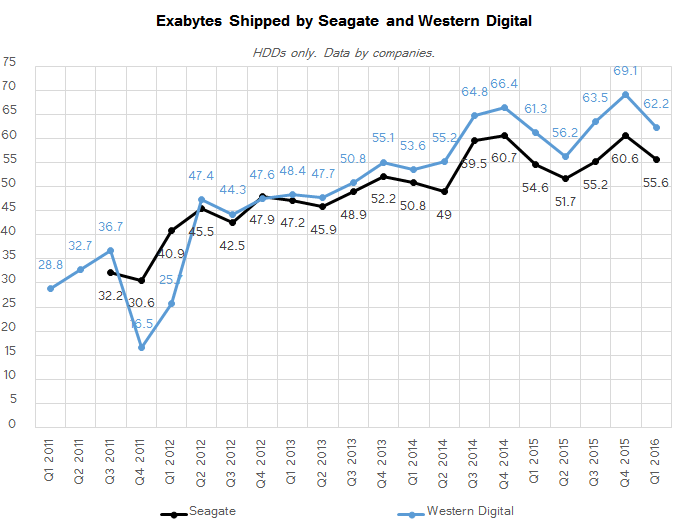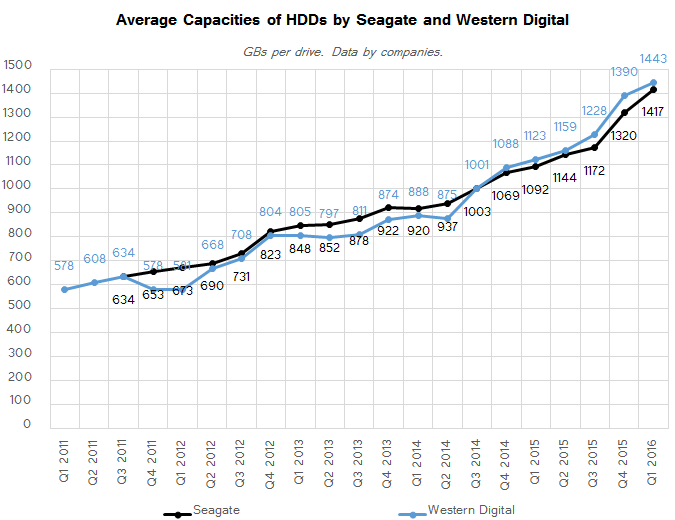Market Views: HDD Shipments Down 20% in Q1 2016, Hit Multi-Year Low
by Anton Shilov on May 12, 2016 8:00 AM ESTAverage HDD Capacities Continue to Increase
Despite the drop in HDD unit shipments, both sequentially and year-over-year, total capacities shipped by the two leading makers of hard drives increased in Q1. Seagate supplied 55.6 EB (Exabyte) of HDD storage last quarter, up from 54.6 EB in Q1 2015, but down from 60.6 EB in the previous quarter. The total capacity of Western Digital’s HDDs shipped in the first quarter of 2016 was approximately 62.2 EB, a moderate increase from 61.3 EB in Q1 2015.
When it comes to hard drives, one thing that has been growing quarter-over-quarter for a long time now is average HDD capacity, particularly in the enterprise segment, but not only there. In Q1 2016, an average drive could store around 1.4 TB of data, an increase of 28.5% (Western Digital) and 29.7% (Seagate) from the same quarter last year.
Average HDD Price Stays at $60 compared to Q1 2015
Despite the local price hikes by HDD makers, the industry can clearly produce more hard drives than it can consume, which is why prices of mass HDD models remain rather low. This will likely change in the future, when consumers shift to higher-capacity drives because of 4K UHD video or other reasons, but right now an average HDD from either Seagate of Western Digital costs approximately $60.
This will likely change after Seagate implements its plans to cut down its manufacturing capacities and supply-demand balance of the market will stabilize. However, it remains to be seen how significantly that is going to change going forward.













116 Comments
View All Comments
Michael Bay - Monday, May 16, 2016 - link
Hybrids have almost died by now for the reason of cost. Little logic in buying a hybrid if you can just get a proper SSD for comparable money.Arbie - Saturday, May 14, 2016 - link
What a great article! It reads like an MBA project. Even more impressive - by, um, a lot - if English is not Anton's first language. Efforts like this keep the shine on Anandtech (and remind us of what we lost in X-Bit Labs). Thanks.poohbear - Sunday, May 15, 2016 - link
so guess that would explain why Western Digital's stock is at its lowest ever @ $36 a share!piasabird - Thursday, May 19, 2016 - link
Part of this is that the current computers have CPU's that are so fast and dependable that it may be taking longer before someone wants to purchase a desktop with a hard drive in it. The computer market is very diverse with many options like video game consoles, Roku, Tablets, Phones Phablets, so there is just less demand for a desktop computer.Summersnow - Saturday, May 21, 2016 - link
This is classic disruption. SSD started from the bottom in terms of capacity. HDD guys thought that was a toy and that HDD will forever be much cheaper $/GB.Problem is once SSDs hit a good enough capacity for $30 per drive oem price, that's the end of HDD. I believe the good enough capacity for 2.5" is 256GB. $30 is around the corner.
HDD has a floor cost. HDD cannot be produced for lower than floor cost by cutting capacity but flash can continuously shrink and deliver lower cost per GB in forseeable future. 2.5" HDD floor cost is probably $25. By the time ssd hits sub $20 for 256Gb, HDDs will have no choice but to give up. All entry level notebook PC models will go for ssd 256GB. HDD TAM will see a sudden huge drop when that happens.
Wolfpup - Thursday, July 14, 2016 - link
That stinks they're getting rid of people.One thing I never understood is why Seagate and Western Digital did pounce all over the SSD (emerging) market 10 years ago. Obviously some of the skill-set involved would overlap, it was obvious they'd become more popular. I guess Seagate's maybe done some enterprise drives? I'm not even sure... but I don't get why they're not one of the biggest names in SSDs...